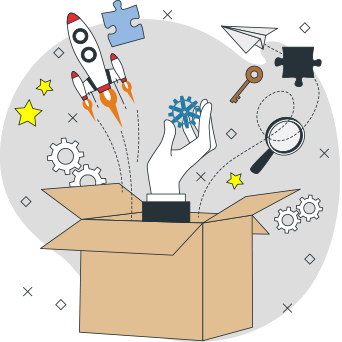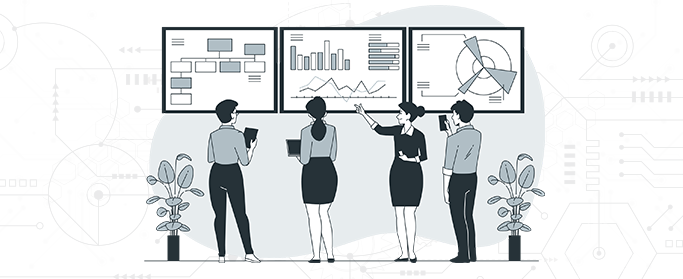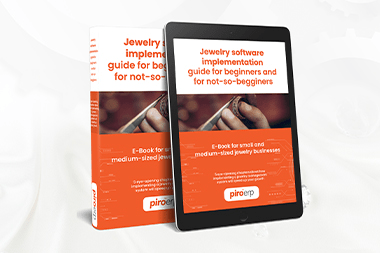Introduction
ERP implementation is never just a tech project - it’s a transformation. In the jewelry industry, where craftsmanship meets complexity, introducing a management system can unlock real efficiency. But without the right approach, it can also become costly, chaotic, or fail entirely. Here's what successful companies get right.

1. "The way we fo it" vs. industry standards: why reinventing the wheel is risky
 Trying to digitize highly custom processes can be expensive and risky. Embracing proven workflows helps reduce costs and supports faster onboarding.
Trying to digitize highly custom processes can be expensive and risky. Embracing proven workflows helps reduce costs and supports faster onboarding.
Jewelry businesses often develop unique ways of managing inventory, production, or sales over time. These “homegrown” processes might work well on paper - or in Excel - but become problematic when moving to an ERP system.
Why? Because ERP systems are built around standardized, best-practice processes used across industries. If your company insists on preserving every custom step, you’ll likely face:
- High customization costs
- Longer implementation timelines
- Difficulties training new employees
Instead of bending the system to fit outdated habits, consider where your business can align with how others work.
2. How digitally mature is your business?
Digital tools won’t fix broken processes. Start by assessing your organization’s readiness - with people and workflows alike.
 Many companies underestimate the importance of internal preparation. Before even selecting a system, ask:
Many companies underestimate the importance of internal preparation. Before even selecting a system, ask:
- Are your processes clearly documented?
- Are roles and responsibilities well defined?
- Is your team open to change?
A simple digital readiness checklist or questionnaire can reveal whether you're prepared - or if foundational work is needed first.
3. You don’t always need a senior consultant.
Even a junior advisor can help if your team owns the process. Internal commitment matters more than external titles.

ERP vendors and consultants can offer valuable support - but they won’t know your business like you do. Even a junior consultant with basic ERP knowledge can guide your team through the process, if your internal stakeholders are actively involved.
Your success depends less on outsourcing expertise and more on internal ownership, clarity, and follow-through.
4. Fit the system to the business - or the business to the system?
Chasing a perfect fit often leads to over-customization. Sometimes, adapting your process is the smarter move.
Companies often expect the ERP to match their way of working exactly. But systems built to fit every nuance become fragile and expensive.
Instead, explore how your processes can evolve to match system logic better. This approach leads to easier upgrades, fewer bugs, and lower total cost of ownership.
5. Clean your data
Bad data leads to bad decisions. Always clean and validate your data before migration - your vendor won’t do it for you.
 One of the most overlooked aspects of ERP projects is data quality. Old systems are often full of duplicates, errors, or inconsistent formats.
One of the most overlooked aspects of ERP projects is data quality. Old systems are often full of duplicates, errors, or inconsistent formats.
Migrating this “dirty” data into your new system just transfers the problem. Data cleaning should be done internally - with clear owners, standards, and validation steps.
Never assume the vendor will fix your data. They won’t.
6. Optimize before you digitize
Digitizing flawed processes locks in inefficiencies. Improve your workflows first - then automate.
ERP software can’t fix poor processes - it only makes them more visible. Before implementation, take the time to map and optimize key workflows: inventory, procurement, production, etc.
Vendors provide tools, not organizational transformation. Identifying bottlenecks and redesigning steps must come from within.
7. Most ERP failures are human, not technical
Lack of planning, time, and internal engagement are the real reasons most projects derail - not the software itself.
Studies show that about 70% of ERP failures are rooted in people and planning - not technology. Common mistakes include:
- Underestimating the time required
- Failing to involve key users early
- Poor communication and unclear expectations
Technology is rarely the issue. Without change management, training, and a clear implementation roadmap, even the best ERP won’t deliver value.
Ready to take your jewelry business to the next level? Let’s start with a consultation call.
FAQ: Jewelry ERP Implementation & Best Practices
- How can PIRO Jewelry ERP software replace outdated, custom processes in a jewelry business?
PIRO Jewelry ERP software replaces outdated spreadsheets and overly customized workflows with proven, industry-standard processes for jewelers. By adopting these best practices, you can reduce ERP implementation costs, speed up onboarding, and improve team productivity. - How does PIRO Jewelry ERP system support the digital readiness of a jewelry retailer or manufacturer?
PIRO Jewelry ERP system helps jewelry retailers and manufacturers prepare for digital transformation by documenting workflows, defining team roles, and setting up standardized processes. This ensures a smoother transition to new technology and maximizes return on investment. - Do I need an expensive ERP consultant to implement PIRO Jewelry ERP software?
You don’t necessarily need a costly ERP consultant to implement PIRO Jewelry ERP software. Many successful implementations are driven by motivated internal teams with PIRO’s onboarding guidance, training, and ongoing support. - How can PIRO Jewelry ERP software help avoid over-customization during implementation?
PIRO Jewelry ERP software uses a flexible yet standardized structure that allows you to adapt your workflows to the system instead of forcing the system to fit inefficient processes. This minimizes complexity, reduces maintenance costs, and makes future updates easier. - How does PIRO Jewelry ERP help improve data quality and streamline process optimization?
PIRO Jewelry ERP software improves data quality by guiding you through data cleaning and structuring before migration. It also supports process optimization, ensuring you only automate refined, efficient workflows.






